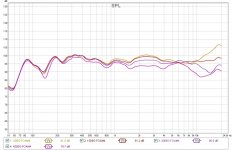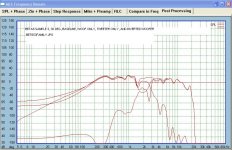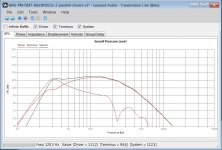Hi,
Not sure you can believe the graph.
First are you sure this freq 'accidents' are possible to correct using eq? What i mean is that there will be diffraction effects caused by the transition from horn to membrane and then by suspension and frame/ gasket.
Not sure if an eq can solve that and not even if it really matters ( for the transition horn/membrane sure it does matter!)?
This is one of the compromise to be made with a coax but from my experience this isn't as awfull to hear that than it looks on a graph ( with Tannoy's and some Beyma drivers i've heard at least).
Not sure you can believe the graph.
First are you sure this freq 'accidents' are possible to correct using eq? What i mean is that there will be diffraction effects caused by the transition from horn to membrane and then by suspension and frame/ gasket.
Not sure if an eq can solve that and not even if it really matters ( for the transition horn/membrane sure it does matter!)?
This is one of the compromise to be made with a coax but from my experience this isn't as awfull to hear that than it looks on a graph ( with Tannoy's and some Beyma drivers i've heard at least).
FWIW, when comparing different scale charts I just look at F6, F10 and both are ~4.5 kHz/9 kHz respectively, so seems like ~ 'six of one, half a dozen of the other' to me. The rest is just minor damping/tweaking to 'taste', so between me being a 'cheapskate' combined with 'poor' in the thread title, the choice seems self evident. 
GM
GM
Radian seems to make good coaxials. Although in the PA market, some have adopted them for domestic use. As an owner of several types of Tannoys I was considering them as an alternative for upgrading my local bar's sound system. I didn't need them in the end, so have no personal experience.
From the specs, the Radians will be loud but you will probably need a sub for true full range if you want to maintain the sensitivity. The compression driver is 44mm so can be crossed over below 2KHz.
You can get (some) second hand smaller Tannoys at reasonable prices. The Saturn, aimed at home theatre is an 8 inch. The passive crossover needed to be completey redesigned to make it monitor worthy, which was not an easy task. The Behringer DCX2496 is outstanding for the money. I and others, have used this in a commercial studio system as well as domestically.
From the specs, the Radians will be loud but you will probably need a sub for true full range if you want to maintain the sensitivity. The compression driver is 44mm so can be crossed over below 2KHz.
You can get (some) second hand smaller Tannoys at reasonable prices. The Saturn, aimed at home theatre is an 8 inch. The passive crossover needed to be completey redesigned to make it monitor worthy, which was not an easy task. The Behringer DCX2496 is outstanding for the money. I and others, have used this in a commercial studio system as well as domestically.
Do you have a xover you can post / link to for this combination?When crossover is done right, they are very special. And they dont break.
It is remarkable what you can find on the WWW with a bit of patience. I'm scanning the WWW for years and bought my complete hybrid studio (run digital audio through an AD/DA convertor to an analog mixing desk, to use the character of the analog desk) all second hand for around 1/5 to 1/10 of the new price. ALL in perfect shape!
Mac Pro's (2x 3.1 version) running the latest OS, 4 striped SSD disk (fast as lightning). I run Presonus Studio One on them and assign the virtual channels of the Studio DAW to the hardware of the desk. So I can do automation (so called "within the box") and mix "outside the box". Very nice concept used in lots of studios.
56 Channel Mackie 8-bus mixer (32-8 bus extended with 1 24-8 bus), VERY English EQ sounding (OK, it's NOT a NEVE desk, I don't mind also because they are NOT affordable by a mile for me). I like to have sliders and knobs at hand.
3 MOTU 24 I/O unit to have 72 AD/DA channels available for the analog desk and out-board gear.
Crown vintage amps (the 250 if I recall correctly)
Tannoy SRM12X, auratone's & Yamaha NS10 matching pair
DBX compressors, Lexicon reverbs, Sennheiser studio mikes
The lot. Disadvantage of second hand? They have been used.....
This Tannoy uses the 2036 driver, looking into T&S parameters, not found yet.
Anyway, for 125 euro per driver, not a bad test version. Once finished this project, I could easily sell them for the same price, R&D expense 0 euro's
To be continued.
Kind regards,
Frans
Mac Pro's (2x 3.1 version) running the latest OS, 4 striped SSD disk (fast as lightning). I run Presonus Studio One on them and assign the virtual channels of the Studio DAW to the hardware of the desk. So I can do automation (so called "within the box") and mix "outside the box". Very nice concept used in lots of studios.
56 Channel Mackie 8-bus mixer (32-8 bus extended with 1 24-8 bus), VERY English EQ sounding (OK, it's NOT a NEVE desk, I don't mind also because they are NOT affordable by a mile for me). I like to have sliders and knobs at hand.
3 MOTU 24 I/O unit to have 72 AD/DA channels available for the analog desk and out-board gear.
Crown vintage amps (the 250 if I recall correctly)
Tannoy SRM12X, auratone's & Yamaha NS10 matching pair
DBX compressors, Lexicon reverbs, Sennheiser studio mikes
The lot. Disadvantage of second hand? They have been used.....
This Tannoy uses the 2036 driver, looking into T&S parameters, not found yet.
Anyway, for 125 euro per driver, not a bad test version. Once finished this project, I could easily sell them for the same price, R&D expense 0 euro's
To be continued.
Kind regards,
Frans
Do you have a xover you can post / link to for this combination?
Hi Brett,
NO, I don't have a cross-over yet. The idea is to use the DSP from the Hypex 3-way module.
I don't think I will opt for a passive crossover, WAY to complicated based on what is most likely needed to make this work.
kind regards,
Frans
The Beta8CX and ASD1K are really good drivers at really good price.
When crossover is done right, they are very special. And they dont break.
AND commercially available.
1 - Are these the frequency responses for that combination of drivers?
2 - How was this measured (in a cabinet, crossover, etc?) If you will...
kind regards,
Frans
FWIW, when comparing different scale charts I just look at F6, F10 and both are ~4.5 kHz/9 kHz respectively, so seems like ~ 'six of one, half a dozen of the other' to me. The rest is just minor damping/tweaking to 'taste', so between me being a 'cheapskate' combined with 'poor' in the thread title, the choice seems self evident.
GM
Commen sense, yes I should stick to the poor mans principle.
I did ask the question, because it stills intrigues me. Is a middle of the road driver (CHEAP) combined with a correct filter (correcting to make it within +- 2 dB) sounding the same as a brilliant (EXPENSIVE) driver that is +- 2dB BY ITSELF???
This topic started in my head when I saw the Danley Synergy horn (commercial product) using VERY cheap mid drivers, most likely because they just matched exactly with what was needed.
kind regards,
Frans
You can get (some) second hand smaller Tannoys at reasonable prices. The Saturn, aimed at home theatre is an 8 inch. The passive crossover needed to be completey redesigned to make it monitor worthy, which was not an easy task. The Behringer DCX2496 is outstanding for the money. I and others, have used this in a commercial studio system as well as domestically.
Which is what I just did...
Behringer has brought out better and better products, seems hard to get rid of their past image.
kind regards,
Frans
TL theory
NO, I have not been ran over by a train...
Busy busy busy with earning some money.
AND;
Before I'll start the target 2x 8" LF / 8" Tannoy DC from my just bought NFM8 S2 Tannoy's (with as the driver if correctly = 2036) combination, I will read the TL theory by Martin J. King. YES, I will carefully disassemble the NFM8's to use the driver. When done, maybe re-assemble them and sell them (R&D cost = 0 euro's on coaxials).
Pearls from Martin J King Quarter Wave Design
So I hope to understand better what a TL is all about (first time to design and build one) and what the TL software I use is telling me.
Keep you posted.
kind regards,
Frans
NO, I have not been ran over by a train...
Busy busy busy with earning some money.
AND;
Before I'll start the target 2x 8" LF / 8" Tannoy DC from my just bought NFM8 S2 Tannoy's (with as the driver if correctly = 2036) combination, I will read the TL theory by Martin J. King. YES, I will carefully disassemble the NFM8's to use the driver. When done, maybe re-assemble them and sell them (R&D cost = 0 euro's on coaxials).
Pearls from Martin J King Quarter Wave Design
So I hope to understand better what a TL is all about (first time to design and build one) and what the TL software I use is telling me.
Keep you posted.
kind regards,
Frans
Last edited:
Tannoy System 8 NFM II
Taking it apart, so I can do the sizing measurement for the Tannoy 2036 driver.
Also made some pictures.
- 25mm front and back panel
- typical Tannoy bracing, but look at the type of wood used, the bracing is done with old school partical board (if that's the correct word). Did they have a warehouse full left from "the early days" or what.
Did they have a warehouse full left from "the early days" or what.
- Wood screws to fix the driver
- The driver is from 19 april 1994, so the cabinet most likely is around that period as well.
There is a coil, separately mounted from the cross-over. It is as far as I have read in various articles on cross-over improvement to reduce coil vibration, which would have a negative impact on the functioning of the filter. A bit far fetched or what?
Also found that the bass-reflex ports in the cabinet are not centered, they don't match the size of the hole in the front panel (by 2 mm on one side).
See pictures for the whole story.
Taking it apart, so I can do the sizing measurement for the Tannoy 2036 driver.
Also made some pictures.
- 25mm front and back panel
- typical Tannoy bracing, but look at the type of wood used, the bracing is done with old school partical board (if that's the correct word).
- Wood screws to fix the driver
- The driver is from 19 april 1994, so the cabinet most likely is around that period as well.
There is a coil, separately mounted from the cross-over. It is as far as I have read in various articles on cross-over improvement to reduce coil vibration, which would have a negative impact on the functioning of the filter. A bit far fetched or what?

Also found that the bass-reflex ports in the cabinet are not centered, they don't match the size of the hole in the front panel (by 2 mm on one side).
See pictures for the whole story.
Attachments
-
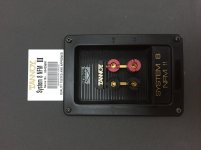 IMG_2468.jpg762.1 KB · Views: 232
IMG_2468.jpg762.1 KB · Views: 232 -
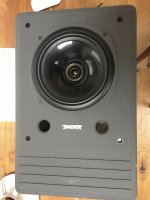 fullsizeoutput_9c4.jpg490.9 KB · Views: 232
fullsizeoutput_9c4.jpg490.9 KB · Views: 232 -
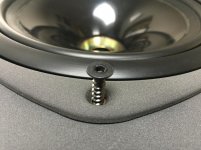 IMG_2447.jpg808.3 KB · Views: 230
IMG_2447.jpg808.3 KB · Views: 230 -
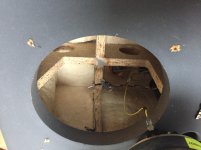 IMG_2453.jpg672.4 KB · Views: 216
IMG_2453.jpg672.4 KB · Views: 216 -
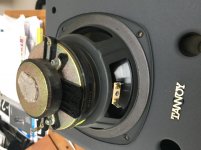 IMG_2458.jpg645.5 KB · Views: 99
IMG_2458.jpg645.5 KB · Views: 99 -
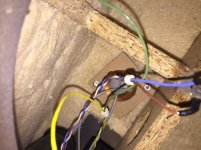 IMG_2455.jpg695.2 KB · Views: 217
IMG_2455.jpg695.2 KB · Views: 217 -
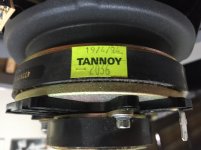 fullsizeoutput_9c8.jpg662.3 KB · Views: 90
fullsizeoutput_9c8.jpg662.3 KB · Views: 90 -
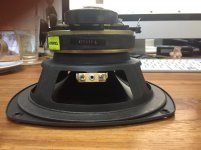 IMG_2469.jpg592.8 KB · Views: 89
IMG_2469.jpg592.8 KB · Views: 89 -
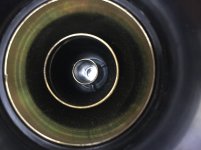 IMG_2474.jpg543.9 KB · Views: 91
IMG_2474.jpg543.9 KB · Views: 91
Last edited:
3x 8" PM DMT draft
This is the first draft for the 8" PM-DMT.
B&C 8NDL51 2x
Tannoy 2036 DC
65 x 65 x 43 cm
It hosts 2x the TL for the B&C 8NDL51 and a closed box for the Tannoy 2036.
That way, I expect to have the bracing complete as well.
kind regards,
Frans
This is the first draft for the 8" PM-DMT.
B&C 8NDL51 2x
Tannoy 2036 DC
65 x 65 x 43 cm
It hosts 2x the TL for the B&C 8NDL51 and a closed box for the Tannoy 2036.
That way, I expect to have the bracing complete as well.
kind regards,
Frans
Attachments
I'd be tempted to run both woofers into one line.
Hi Charles,
I shure would FEEL tempted ...
I understand the principles of a TL, don't know the in & outs & tricks of a TL yet. The Leonardo software does not support multiple drivers in one TL.
kind regards,
Frans
In theory it should be sufficient in your calculation to double Vas and Sd in order to use two drivers in one line.
Makes sense and since a driver is both an electrical device and a mechanical device, adding at least for the electrical device;
Re, Pe and Lvc. SPL will also be impacted
For 2 identical drivers in parallel that would make;
Vas = 2x driver Vas
Sd = 2x driver Sd
Re = driver Re / 2
Lvc = 2x driver Lvc
Pe = 2x driver Pe
SPL = SPL of single driver + 6dB
Mechanical;
Mms = 2x driver Mms
I would expect the following T&S parameters to stay the same;
Fs, Qts, Qms, Qes, BI and Xmax.
NOTE: The driver OFFSET location is only used slightly different when having 2 drivers one above the other in the path of the line. When they are NEXT to each other, the offset point will be the centre of both drivers.
I would expect it is safe to mount the drivers right against each other with the offset point being right between the 2 drivers. So the first driver (seen from the closed end of the TL) will have its edge right UNDER the offset point and the second driver will have its edge right ABOVE the offset point. Making the center of these 2 combined right on the offset point.
In my design the driver offset is not impacted, since the 2 drivers sit next to each other AT the offset point in the TL.
I will use these new values, but assume the outcome is much more easy then expected. For a PARALLEL connected second driver, the TL will just double in width. Let's see how the Leonardo software I use sims the double driver TL.
keep you posted. PLEASE correct me if I seem to go wrong here.
kind regards,
Frans
Last edited:
2 Driver TL design rules
Following on the previous post, as suggested by Charles, I used the driver T&S parameter rules for 2 parallel drivers in one TL.
As hoped / expected it came out very nice, just 2x the width of the TL when applying T&S parameter changes based on 2 parallel drivers.
First graph is 1 driver, second graph is 2 parallel drivers. 6dB more, TL, offset and the likes the same.
Recap on T&S calc;
Vas = 2x driver Vas
Sd = 2x driver Sd
Re = driver Re / 2
Lvc = 2x driver Lvc
Pe = 2x driver Pe
SPL = SPL of single driver + 6dB (not supported by the Leonard software, but does show in second graph).
Mechanical;
Mms = 2x driver Mms
Done.
kind regards,
Frans
Following on the previous post, as suggested by Charles, I used the driver T&S parameter rules for 2 parallel drivers in one TL.
As hoped / expected it came out very nice, just 2x the width of the TL when applying T&S parameter changes based on 2 parallel drivers.
First graph is 1 driver, second graph is 2 parallel drivers. 6dB more, TL, offset and the likes the same.
Recap on T&S calc;
Vas = 2x driver Vas
Sd = 2x driver Sd
Re = driver Re / 2
Lvc = 2x driver Lvc
Pe = 2x driver Pe
SPL = SPL of single driver + 6dB (not supported by the Leonard software, but does show in second graph).
Mechanical;
Mms = 2x driver Mms
Done.

kind regards,
Frans
Attachments
Last edited:
Tannoy seems to have had different versions of their 8 inch drivers. The NFM8 drivers seems similar to that in the Saturn and System 800. I don't have the model numbers to hand, but the System 800 driver behavior was different to the Saturn. The System 800 was supposed to be a nearfield monitor but the one I had was a complete mess, and seems to be something dreamt up by marketing, not engineers. So don't believe the 'monitor' hype.
The critical aspect is the crossover frequency for a 1 inch tweeter. Tannoy try to crossover at a lower frequency than is the norm, but this puts stress on the tweeter. I found that ~ 1.8KHz was achievable with a third order slope. The Saturn based design is able to take being driven by a 250W MOSFET and plays clean to loud levels.
As for cheap vs costly drivers - it is usually how break up modes are controlled, and the materials needed for that. The manufacturing processes that KEF and Tannoy use for their coaxials means a more expensive driver. I still prefer the Tannoy approach overall. If the drivers are well matched, the imaging can't be beaten.
The critical aspect is the crossover frequency for a 1 inch tweeter. Tannoy try to crossover at a lower frequency than is the norm, but this puts stress on the tweeter. I found that ~ 1.8KHz was achievable with a third order slope. The Saturn based design is able to take being driven by a 250W MOSFET and plays clean to loud levels.
As for cheap vs costly drivers - it is usually how break up modes are controlled, and the materials needed for that. The manufacturing processes that KEF and Tannoy use for their coaxials means a more expensive driver. I still prefer the Tannoy approach overall. If the drivers are well matched, the imaging can't be beaten.
Any reason you chose the 8NDL51 over the 8FG51?
They where first and second in the test with the TL software at almost the same price, the 8FG51 the cheaper version.
8NDL51 was 1,5 dB more efficient (simmed that is) and easier to get good results in designing the theoretical TL.
Price wise, it's just a few euro's more expensive. The 8FG51 is almost a drop in replacement in the TL for the 8NDL51.
The 8NDL51 also uses a neodymium magnet, making it a more powerful driver.
Nothing more than that.
To be honest, I don't know why these two drivers are brought on the market.
kind regards,
Frans
- Status
- This old topic is closed. If you want to reopen this topic, contact a moderator using the "Report Post" button.
- Home
- Loudspeakers
- Multi-Way
- The POOR man's Tannoy DMT - AKA "The PM-DMT"
